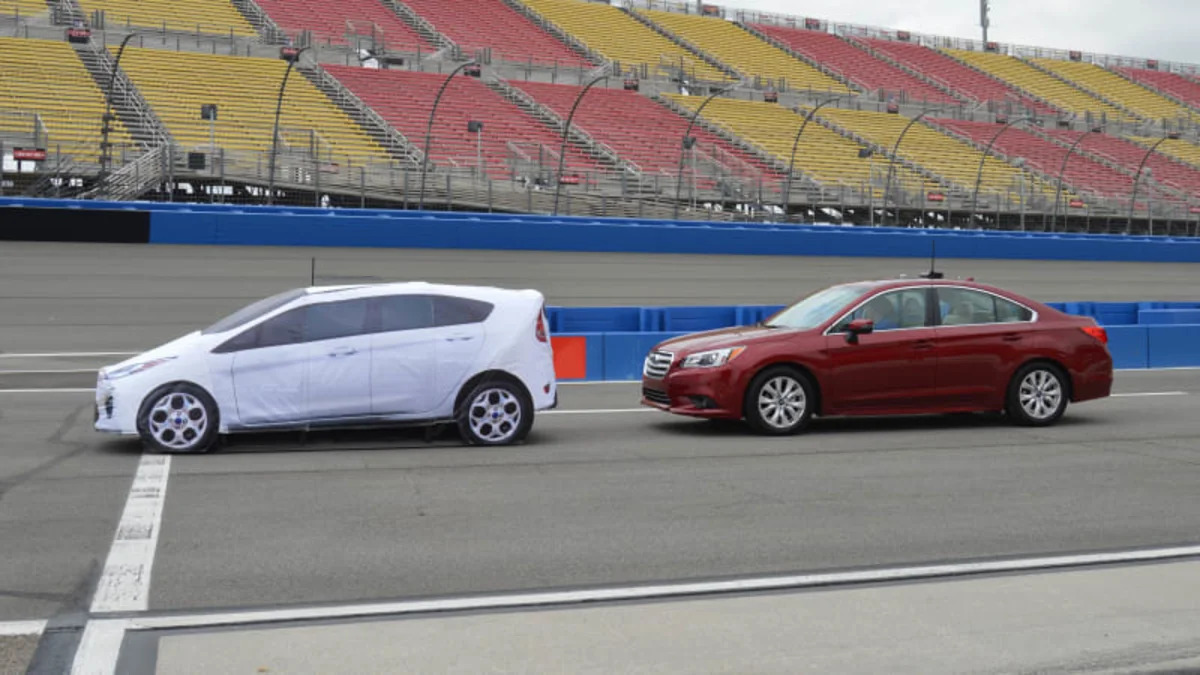Automatic braking systems cars are rapidly becoming more commonplace, and they will be standard on the majority of new cars by 2022. Although these features will eventually become standard, the American Automobile Association (AAA) discovered that their abilities are anything but.
AAA tested five 2016 vehicles, a Volvo XC90, a Subaru Legacy, a Lincoln MKX, a Honda Civic and a Volkswagen Passat to see how each car's braking system reacted when a crash was imminent. Each of these cars had one of two kinds of emergency braking: a collision avoidance system or a collision mitigation system. The collision avoidance type attempts to avoid a crash altogether and can even fully stop the car before hitting an object ahead of it. A collision mitigation system, on the other hand, isn't designed to totally prevent a crash. Instead, it tries to slow the car down to reduce the damage from the crash. AAA determined from the vehicles' owner's manuals that the XC90, Legacy, and MKX all have systems designed to try to prevent a collision, while the Passat and Civic are only able to mitigate a crash.
The differences in the two systems were made quite clear in AAA's testing. Overall, avoidance systems managed to reduce a vehicle's speed by twice as much as the mitigation systems before hitting the obstacle. The avoidance systems were also, unsurprisingly, more effective at preventing a crash, but they weren't infallible. In tests with a speed differential of 30 mph, avoidance systems managed to prevent a collision 60 percent of the time. Mitigation systems did worse, but still managed to stop short of the obstacle 33 percent of the time.
The above testing was done under conditions for which the manufacturers designed the systems. However, AAA also tried out the systems at speeds beyond the ideal conditions, specifically at 45 mph with a stationary object. The collision avoidance-equipped cars performed admirably, slowing the car by 74 percent. Unfortunately, cars with collision mitigation systems lost most of their effectiveness, only slowing the car by nine percent.
The takeaway for consumers is, make sure you fully understand that when car companies advertise emergency braking features, they aren't all promoting the same thing. Both systems can be helpful for avoiding a crash or lessening the impact, but it's important to know the limits of the system. And we agree with AAA that these systems "are never a substitute for an engaged driver." So consumers, stay informed and stay alert.
Related Video:

AAA tested five 2016 vehicles, a Volvo XC90, a Subaru Legacy, a Lincoln MKX, a Honda Civic and a Volkswagen Passat to see how each car's braking system reacted when a crash was imminent. Each of these cars had one of two kinds of emergency braking: a collision avoidance system or a collision mitigation system. The collision avoidance type attempts to avoid a crash altogether and can even fully stop the car before hitting an object ahead of it. A collision mitigation system, on the other hand, isn't designed to totally prevent a crash. Instead, it tries to slow the car down to reduce the damage from the crash. AAA determined from the vehicles' owner's manuals that the XC90, Legacy, and MKX all have systems designed to try to prevent a collision, while the Passat and Civic are only able to mitigate a crash.
The differences in the two systems were made quite clear in AAA's testing. Overall, avoidance systems managed to reduce a vehicle's speed by twice as much as the mitigation systems before hitting the obstacle. The avoidance systems were also, unsurprisingly, more effective at preventing a crash, but they weren't infallible. In tests with a speed differential of 30 mph, avoidance systems managed to prevent a collision 60 percent of the time. Mitigation systems did worse, but still managed to stop short of the obstacle 33 percent of the time.
The above testing was done under conditions for which the manufacturers designed the systems. However, AAA also tried out the systems at speeds beyond the ideal conditions, specifically at 45 mph with a stationary object. The collision avoidance-equipped cars performed admirably, slowing the car by 74 percent. Unfortunately, cars with collision mitigation systems lost most of their effectiveness, only slowing the car by nine percent.
The takeaway for consumers is, make sure you fully understand that when car companies advertise emergency braking features, they aren't all promoting the same thing. Both systems can be helpful for avoiding a crash or lessening the impact, but it's important to know the limits of the system. And we agree with AAA that these systems "are never a substitute for an engaged driver." So consumers, stay informed and stay alert.
Related Video:



Sign in to post
Please sign in to leave a comment.
Continue